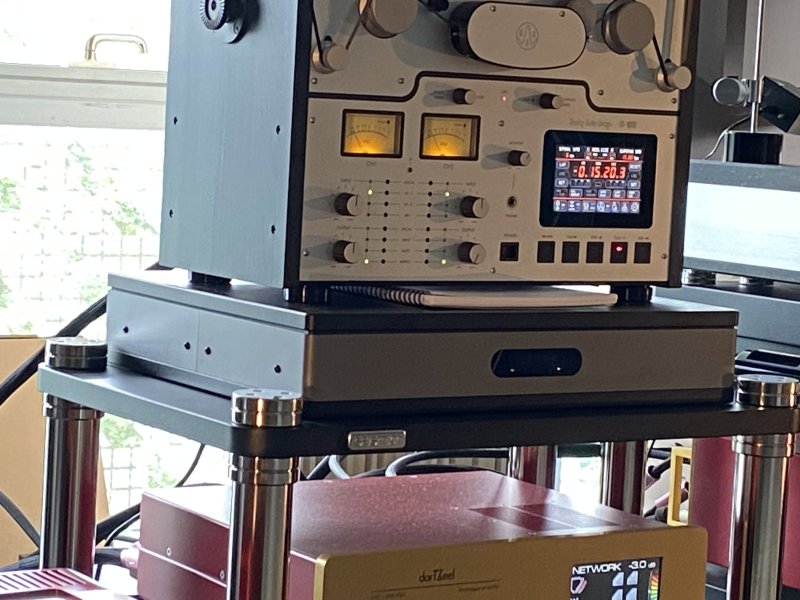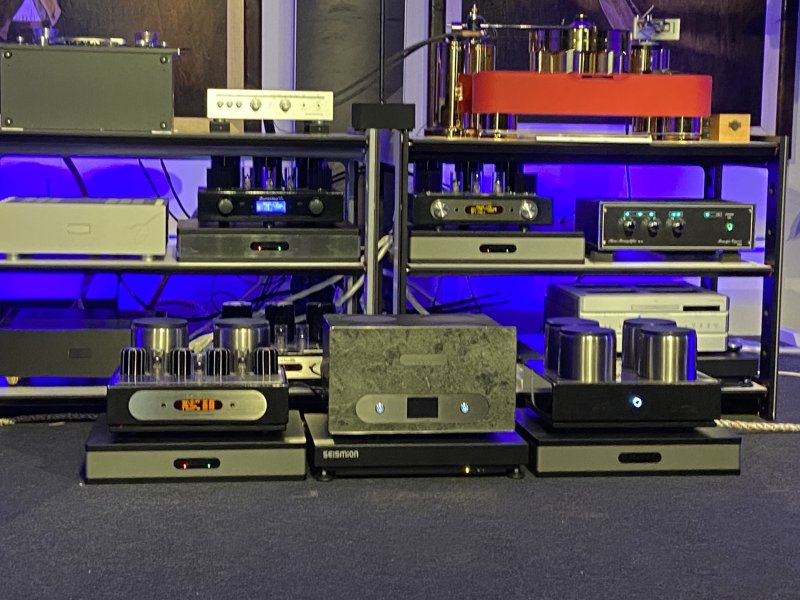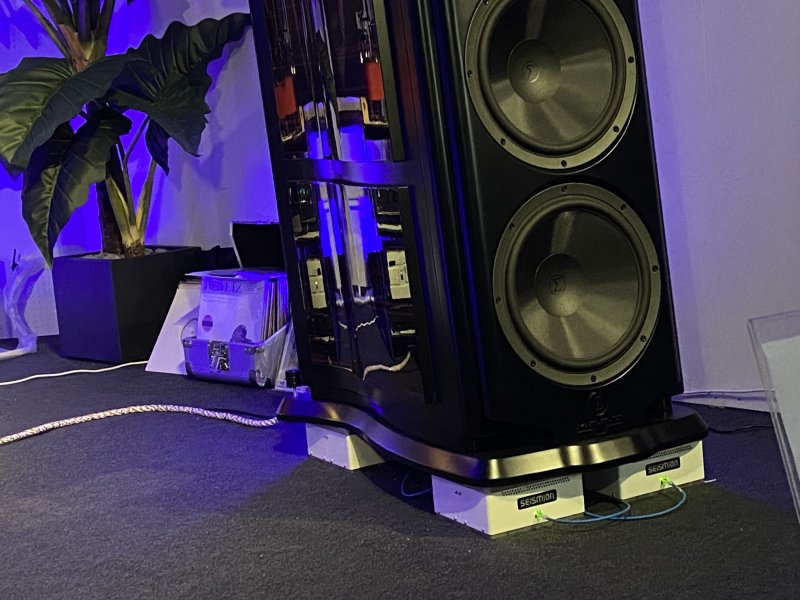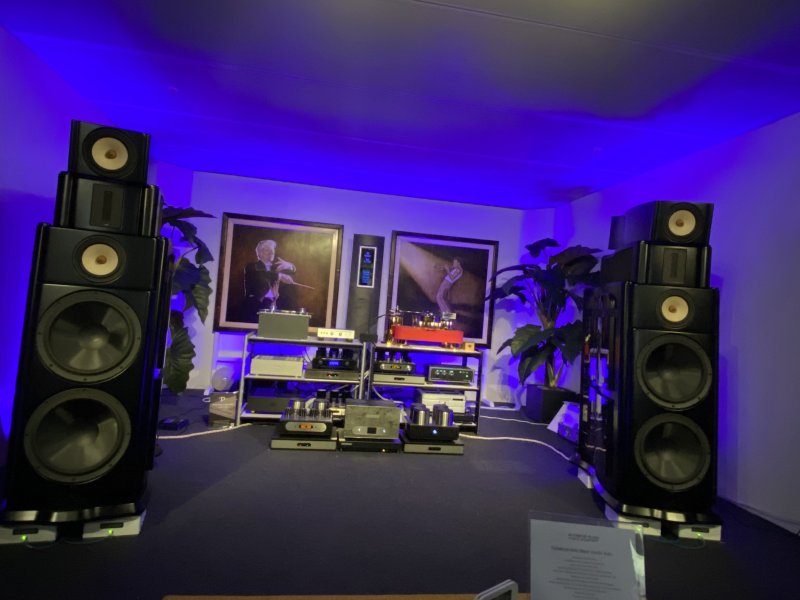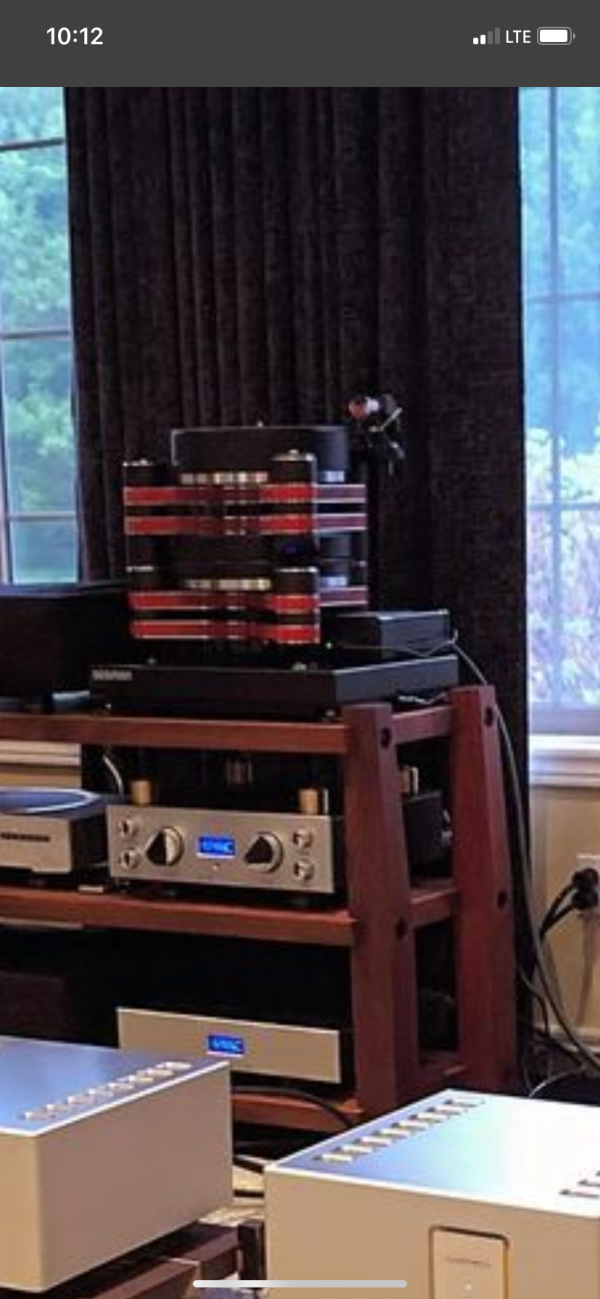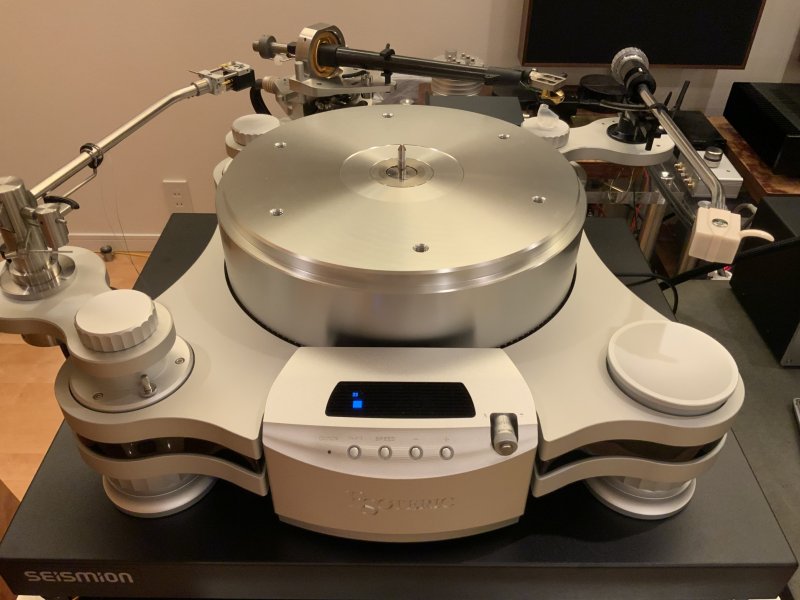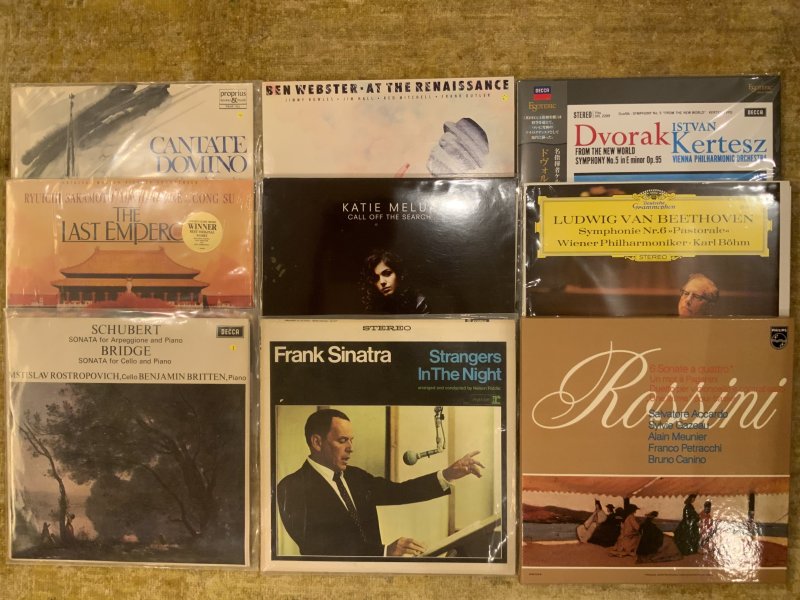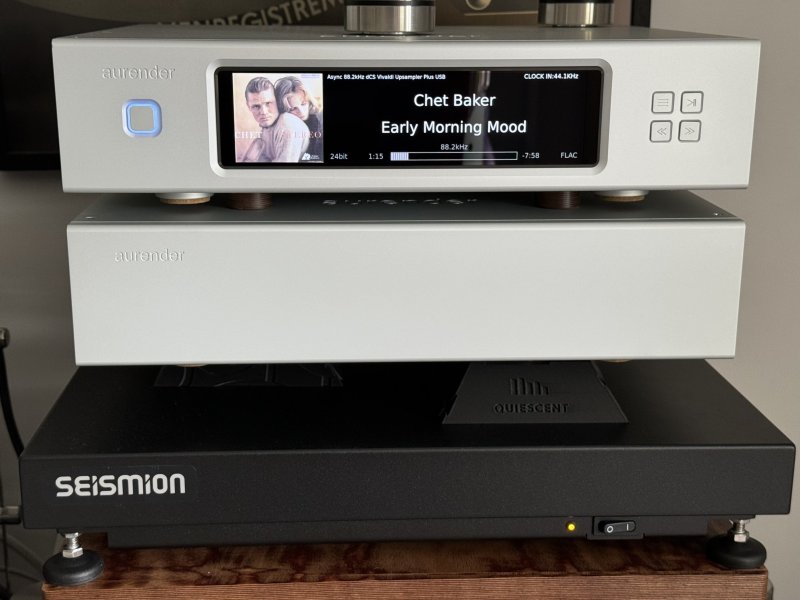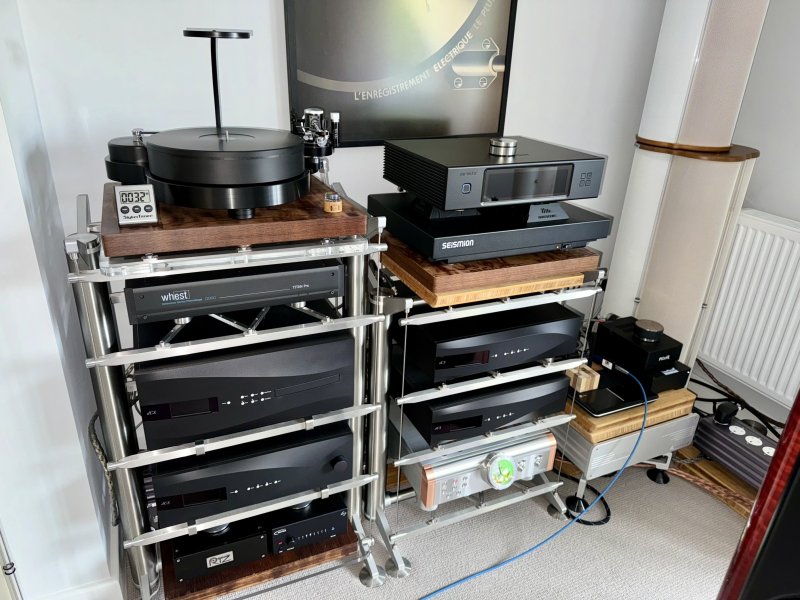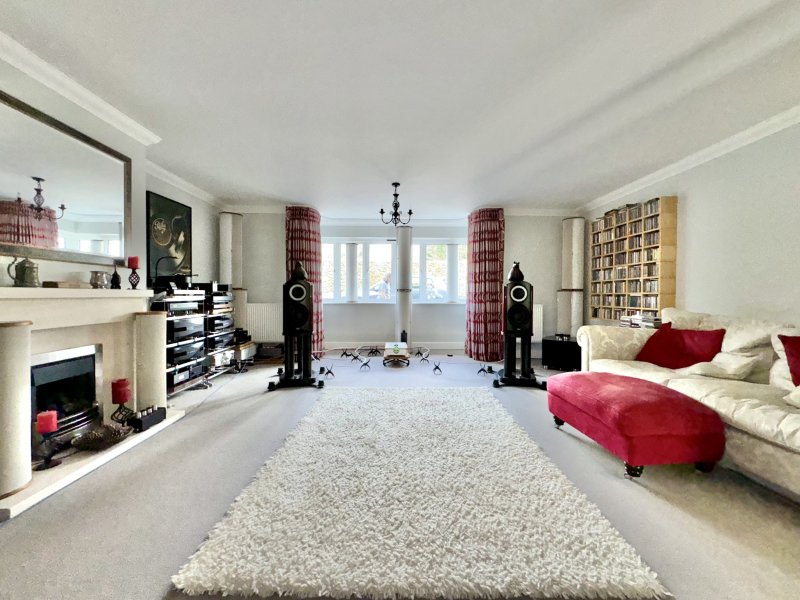Seismion - new active isolation platform from Germany
- Thread starter TLi
- Start date
You are using an out of date browser. It may not display this or other websites correctly.
You should upgrade or use an alternative browser.
You should upgrade or use an alternative browser.
The Reactio 1 and Plus have a aluminium honeycomb structure with 20mm thickness and a 1.5mm steel sheet metal glued on top. This gives stiffness and damping.
Sebastian
Sebastian
I can concur with having tried this ourselves under the Helix One!In fact, Helmut Thiele, who is using a special version of our Reactio for his own turntable "Thiele TT01", is doing exactly the way you suggest: one turntable directly on the rack, a second one on his active (Seismion) platform. For all his auditions at distributors and dealers, the audience was immediately aware of the huge improvement due to the isolation. We have also witnessed it once, and honestly: it exceeded all our expectations!
We also know of some people who tried our isolator under a Dohmann Helix One turntable. As you might know, this turntable uses the passive isolation system from MinusK. After placing our Reactio below, a further improvement was clearly achieved.
Marcus
Seismion will be accompanying The Audio Association at T.H.E. Show this upcoming weekend in Cosa Mesa in the Bristol 1 room. I believe it will be used under the Wave Kinetics NVS turntable at T.H.E. Show. @TheAudioAssociation @Seismion
Also launched at the Munich High End Show by @Seismion is the upcoming Reactio 2.0. Shown in the pictures is the 500x400 model. Please refer to the Seismion explanation on the isolation ability of the Reactio 2.0 later in this thread. Load capacity of up to 60 kg (132 lbs). Self levelling ability (top plate relative to the base) allowing for accurate correction of components with centroids that are off centre. We were very impressed with the demonstration of these. There will be a 600x 500 model and later a higher capacity model of each also introduced. We are looking forward to receiving our units!
The greatest demonstration was with the Sigma loudspeakers and the Atlas isolators. The demonstration was very readily apparent to everyone listening. This will be an exciting product development as it comes along.
The greatest demonstration was with the Sigma loudspeakers and the Atlas isolators. The demonstration was very readily apparent to everyone listening. This will be an exciting product development as it comes along.
Attachments
Last edited:
i can tell you that is a very good match, had my NVS on active for 8 years. zero apparent self noise from the NVS (according to the Herzan read-out) so optimal boost from active. exceptional micro dynamics, focus and bass articulation. lack of smearing dynamic peaks. show conditions and noise levels are not the ideal place to hear everything this combo can do, but i'm sure it will do some fun stuff.Seismion will be accompanying The Audio Association at T.H.E. Show this upcoming weekend in Cosa Mesa in the Bristol 1 room. I believe it will be used under the Wave Kinetics NVS turntable at T.H.E. Show. @TheAudioAssociation @Seismion
Last edited:
I painstakingly (with help from my partner) compared all of my gears on and off Seismion. That comparison (A/B/A) included HRS, and CMS TT footers (and bunch of others). The difference was readily apparent (in favor of Seismion), also confirmed by partner - she has better ears than I do.I answered this on #201
Unfortunately that's not the correct way of evaluating it. The correct way is: component over Seismion and it's on vs component over the rack/platform or on the floor.
I'm happy for them. I hope they didn't just turn Seismion on and off when reaching the above conclusion.
The dynamics, aliveness, resolution, jump factor, transparency with relaxation, undistorted realism, etc everything increased with Seismion without affecting tonality. passive devices I tried although good on their own way, were colored.
I don’t know if some electronics are tuned to be vibrated like some BBC/thin walled speakers are. But better isolation turn into better sound in my case. I’ve 4 Seismions in my system add the cumulative effect has been more than their sum. I plan to add more Seismion when budget allows. In all honesty, this has been one of the best audio investment I’ve made in recent years.
Btw, my floors are wood over concrete. Rack is from Core Audio Design. I use linear power supply with Cardas DC cables. All the thick cables connecting the gears resting on top of Seismion have vibration dampening cable elevators to reduce strain and minimize vibration transmission.
Last edited:
I've had similar sonic benefits using Seismion tables under all of my components, but I have not gone to great lengths for comparison to other footers and passive devices (was using Herzan tables before). I'm curious: what LPS's are you using to power your Seismion's? That's my next step.I painstakingly (with help from my partner) compared all of my gears on and off Seismion. That comparison (A/B/A) included HRS, and CMS TT footers (and bunch of others). The difference was readily apparent (in favor of Seismion), also confirmed by partner - she has better ears than I do.
The dynamics, aliveness, resolution, jump factor, transparency with relaxation, undistorted realism, etc everything increased with Seismion without affecting tonality. passive devices I tried although good on their own way, were colored.
I don’t know if some electronics are tuned to be vibrated like some BBC/thin walled speakers are. But better isolation turn into better sound in my case. I’ve 4 Seismions in my system add the cumulative effect has been more than their sum. I plan to add more Seismion when budget allows. In all honesty, this has been one of the best audio investment I’ve made in recent years.
Btw, my floors are wood over concrete. Rack is from Core Audio Design. I use linear power supply with Cardas DC cables. All the thick cables connecting the gears resting on top of Seismion have vibration dampening cable elevators to reduce strain and minimize vibration transmission.
back when i first acquired my Tana/Herzan platforms, i did exactly this experiment under my darTZeel amplifiers; i asked a couple of local friends to come over and we went through the pain of trying the amps on and off my passive amp stands, and on the active devices. then we compared the active devices on the active shelf turned on and off. the active device turned off was better than the floor or my Box Furniture amp stands. but turned on was better than the others in a very special way.I painstakingly (with help from my partner) compared all of my gears on and off Seismion. That comparison (A/B/A) included HRS, and CMS TT footers (and bunch of others). The difference was readily apparent (in favor of Seismion), also confirmed by partner - she has better ears than I do.
The dynamics, aliveness, resolution, jump factor, transparency with relaxation, undistorted realism, etc everything increased with Seismion without affecting tonality. passive devices I tried although good on their own way, were colored.
I don’t know if some electronics are tuned to be vibrated like some BBC/thin walled speakers are. But better isolation turn into better sound in my case. I’ve 4 Seismions in my system add the cumulative effect has been more than their sum. I plan to add more Seismion when budget allows. In all honesty, this has been one of the best audio investment I’ve made in recent years.
Btw, my floors are wood over concrete. Rack is from Core Audio Design. I use linear power supply with Cardas DC cables. All the thick cables connecting the gears resting on top of Seismion have vibration dampening cable elevators to reduce strain and minimize vibration transmission.
other places i use active i've already used other passive devices prior to using the active and so was very familiar with the transitional performance. collective use of active under the whole signal path is additive.
there are many things it delivers. but the easy one is active further removes the music from the drivers. that distortion it lowers is a noise reducing realism. also active tweaking i've done by completely unweighting my speaker and signal cables from the amp chassis really boosted micro dynamic life. active does benefit from reducing any damping from cables.
renaissens.com from Paris/France have conducted a review of the Wellfloat 3545S and our Reactio plus (in french language). We made contact with them during the Munich High-End, where they experienced our isolators under darTZeel, and they got one demo sample afterwards for their tests:
https://www.renaissens.com/blog/pos...bles-et-de-supports-antivibratoires-2024.html
Here are some snippets of the overall extremely positive review (automatic translation by Google):
"Placed under the Esoteric N-05 XD, this base manages to immerse you directly into the recording studio. Never had we heard a bass descend so low and with so much impact. What relief and what naturalness, it breathes, it sounds wonderfully, it is dynamic and detailed without ever being analytical. You will forget the walls and everything around you. A new era begins..."
Some further listening impressions:
The Cranberries - No need to argue - Zombie:
"This powerful and angry message is fully expressed on our speakers. The Seismion platform brings power, authority and sharpness to the low end. The beat is well marked on the drums positioned in the background. A marvel on the saturated guitar. It sends heavy wood and the listening always remains very solid from one end of the piece to the other, very balanced, the sensations of the concert are not far away!
Rock, real, just the way we like it."
Max Richter - Hostiles – Cradle to the grave:
"The Seismion platform succeeds in producing impressively clear bass. Very powerful sound waves literally hit your solar plexus. From this point of view, the Reactio Plus does much better than any other platform on this criterion with incredible firmness."
Carmina Burana:
"The layering of the sound planes is remarkable, the sources are punctual, the air circulates between the instruments.
The word blur doesn't seem to be part of the Seismion vocabulary!"
For everybody interested, renaissence is pleased to make an appointment, if you like to listen to one of these models and you stay in Paris region: phone 01 84 19 43 88
https://www.renaissens.com/blog/pos...bles-et-de-supports-antivibratoires-2024.html
Here are some snippets of the overall extremely positive review (automatic translation by Google):
"Placed under the Esoteric N-05 XD, this base manages to immerse you directly into the recording studio. Never had we heard a bass descend so low and with so much impact. What relief and what naturalness, it breathes, it sounds wonderfully, it is dynamic and detailed without ever being analytical. You will forget the walls and everything around you. A new era begins..."
Some further listening impressions:
The Cranberries - No need to argue - Zombie:
"This powerful and angry message is fully expressed on our speakers. The Seismion platform brings power, authority and sharpness to the low end. The beat is well marked on the drums positioned in the background. A marvel on the saturated guitar. It sends heavy wood and the listening always remains very solid from one end of the piece to the other, very balanced, the sensations of the concert are not far away!
Rock, real, just the way we like it."
Max Richter - Hostiles – Cradle to the grave:
"The Seismion platform succeeds in producing impressively clear bass. Very powerful sound waves literally hit your solar plexus. From this point of view, the Reactio Plus does much better than any other platform on this criterion with incredible firmness."
Carmina Burana:
"The layering of the sound planes is remarkable, the sources are punctual, the air circulates between the instruments.
The word blur doesn't seem to be part of the Seismion vocabulary!"
For everybody interested, renaissence is pleased to make an appointment, if you like to listen to one of these models and you stay in Paris region: phone 01 84 19 43 88
Sure you mean the Reactio plus and not the initial Reactio? Sebastian said, isolation performance of the plus and the 2.0 is the same.twice the isolation capability of the PLUS (543 and 653 models)
The isolation performance is too complex to be described by just one value. In fact, it is at least a frequency dependent parameter, as you can see in below figure.Sure you mean the Reactio plus and not the initial Reactio? Sebastian said, isolation performance of the plus and the 2.0 is the same.
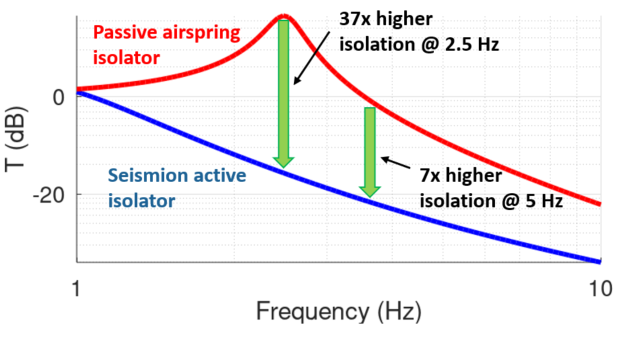
The transmissibility T is a measure how much the vibrations above the isolator are reduced compared to the ground vibrations. So, in other words, this is the isolation performance.
In above figure there is a qualitative comparison of a typical passive airspring isolator with an active isolator (it is NOT the current Reactio plus model, because the Reactio plus already has about -10 dB at 1 Hz, so it is even better than the blue line). As you can see in the airspring, there is a peak around 2.5 Hz, which is related to the resonance amplification, and only for higher frequencies a real isolation sets in. For the active isolator, the resonance is below 1 Hz, so that in the whole frequency range shown above we have already isolation.
If you now take the ratio of both transmissibilities, then you get the improvement from the passive to the active isolator, which is again frequency dependent. In this example, the isolation around 1 Hz is nearly identical, but around 2.5 Hz, due to the resonance, reaches a factor of 37, and eventually resulting in about 5 times for higher frequencies.
Which frequency is most important for music reproduction remains a topic to be discussed. Typically (as I posted in a previous message), the amplitudes around 2-5 Hz are the highest, so the isolation in that range should have a dominant effect.
When we compare the Reactio plus and the new Reactio 2, these curves will also differ from each other (not as much as in above figure). We will post the final results once we fixed all parameters and did the measurements.
Sharing my experience with Reactio Plus under Esoteric Grandioso T1. In a nutshell - needs patience to fine-tune setup to get the most out of the Reactio Plus, but worth the time and effort.
First setup following the instructions had the springy suspension set to about 1.5mm from the lowest level (instructions tell you to have at least 1.5mm movement up/down). I A/B/A tested a number of records and genres (see pictures) to get a better understanding of how the Reactio Plus affected dynamics, soundstage, musicality, etc
With the first setup, the Reactio Plus had a positive impact on soundstage, bass and separation. For example:
Cantate Domino - track A1
Last Emperor - track B1
Second setup - I adjusted the platform such that there was now 1.5mm movement from the highest level, making the suspension stiffer. I hoped that this would yield better dynamics (like driving a sports car with stiffer suspension to get a more responsive ride).
With this setup, each track improved in musicality with faster transients. But perhaps also some reduction in the other positive attributes from setup 1.
So what to do? I called Sebastian (Seismion) to share my experience and to get a better understanding of what was happening. Sebastian explained that there is a 5mm movement between upper / lower level, and setting the level with 2.5mm up/down movement should be optimal.
So third setup (2.5mm up/down movement) ...
Voila - improvements all round.
In summary, the Reactio Plus does a good job as an isolation platform even when switched off. It is an improvement over just placing my T1 on the top shelf of the FE rack. With it switched on, the major improvements are wider / deeper soundstage, deeper bass, better instrument separation and positioning, vocals more present, and more "you are there-3D" sound. Especially good if you listen to a lot of large scale orchestral music.
Other callouts:
First setup following the instructions had the springy suspension set to about 1.5mm from the lowest level (instructions tell you to have at least 1.5mm movement up/down). I A/B/A tested a number of records and genres (see pictures) to get a better understanding of how the Reactio Plus affected dynamics, soundstage, musicality, etc
With the first setup, the Reactio Plus had a positive impact on soundstage, bass and separation. For example:
Cantate Domino - track A1
- Organ deeper more oomph
- Trumpet more expanded
- more separation, richer voices (hear around the edges)
Last Emperor - track B1
- Less attack and seemingly slower pace / dynamics during the first 30 seconds
Second setup - I adjusted the platform such that there was now 1.5mm movement from the highest level, making the suspension stiffer. I hoped that this would yield better dynamics (like driving a sports car with stiffer suspension to get a more responsive ride).
With this setup, each track improved in musicality with faster transients. But perhaps also some reduction in the other positive attributes from setup 1.
So what to do? I called Sebastian (Seismion) to share my experience and to get a better understanding of what was happening. Sebastian explained that there is a 5mm movement between upper / lower level, and setting the level with 2.5mm up/down movement should be optimal.
So third setup (2.5mm up/down movement) ...
Voila - improvements all round.
In summary, the Reactio Plus does a good job as an isolation platform even when switched off. It is an improvement over just placing my T1 on the top shelf of the FE rack. With it switched on, the major improvements are wider / deeper soundstage, deeper bass, better instrument separation and positioning, vocals more present, and more "you are there-3D" sound. Especially good if you listen to a lot of large scale orchestral music.
Other callouts:
- Different tomearm/cartridges behave slightly differently. FR66s/DaVa Soul and Tosca/ATMC2022 benefit more from the platform switched on, whilst Analog Technik DST15 Ice Age had marginal benefits
- Changing the stock feet on the Reactio Plus to Revopods further improved the sound for me
- For fine-tuning performance, place the platform with TT/component on some short (2 inches sufficient) blocks to make it easier to adjust level. Measure the height of the platform at the lowest and highest levels using callipers, and adjust to 2.5mm up/down movement. Once done, remove the blocks and position correctly
Attachments
Fully agree with David's report, I was in his room last weekend when he demonstrated the changes he mentioned. The tension in the suspension springs can affect the sound which is audible. User can adjust it to his preference. It is quite time consuming but very valuable to advanced user.Sharing my experience with Reactio Plus under Esoteric Grandioso T1. In a nutshell - needs patience to fine-tune setup to get the most out of the Reactio Plus, but worth the time and effort.
First setup following the instructions had the springy suspension set to about 1.5mm from the lowest level (instructions tell you to have at least 1.5mm movement up/down). I A/B/A tested a number of records and genres (see pictures) to get a better understanding of how the Reactio Plus affected dynamics, soundstage, musicality, etc
With the first setup, the Reactio Plus had a positive impact on soundstage, bass and separation. For example:
Cantate Domino - track A1
However, I felt there was a reduction in fast transients - making some pieces sound less musical. For example:
- Organ deeper more oomph
- Trumpet more expanded
- more separation, richer voices (hear around the edges)
Last Emperor - track B1
- Less attack and seemingly slower pace / dynamics during the first 30 seconds
Second setup - I adjusted the platform such that there was now 1.5mm movement from the highest level, making the suspension stiffer. I hoped that this would yield better dynamics (like driving a sports car with stiffer suspension to get a more responsive ride).
With this setup, each track improved in musicality with faster transients. But perhaps also some reduction in the other positive attributes from setup 1.
So what to do? I called Sebastian (Seismion) to share my experience and to get a better understanding of what was happening. Sebastian explained that there is a 5mm movement between upper / lower level, and setting the level with 2.5mm up/down movement should be optimal.
So third setup (2.5mm up/down movement) ...
Voila - improvements all round.
In summary, the Reactio Plus does a good job as an isolation platform even when switched off. It is an improvement over just placing my T1 on the top shelf of the FE rack. With it switched on, the major improvements are wider / deeper soundstage, deeper bass, better instrument separation and positioning, vocals more present, and more "you are there-3D" sound. Especially good if you listen to a lot of large scale orchestral music.
Other callouts:
- Different tomearm/cartridges behave slightly differently. FR66s/DaVa Soul and Tosca/ATMC2022 benefit more from the platform switched on, whilst Analog Technik DST15 Ice Age had marginal benefits
- Changing the stock feet on the Reactio Plus to Revopods further improved the sound for me
- For fine-tuning performance, place the platform with TT/component on some short (2 inches sufficient) blocks to make it easier to adjust level. Measure the height of the platform at the lowest and highest levels using callipers, and adjust to 2.5mm up/down movement. Once done, remove the blocks and position correctly
(Sigh.) Well, thanks for instilling more audiophilia nervosa on this.Sharing my experience with Reactio Plus under Esoteric Grandioso T1. In a nutshell - needs patience to fine-tune setup to get the most out of the Reactio Plus, but worth the time and effort.
First setup following the instructions had the springy suspension set to about 1.5mm from the lowest level (instructions tell you to have at least 1.5mm movement up/down). I A/B/A tested a number of records and genres (see pictures) to get a better understanding of how the Reactio Plus affected dynamics, soundstage, musicality, etc
With the first setup, the Reactio Plus had a positive impact on soundstage, bass and separation. For example:
Cantate Domino - track A1
However, I felt there was a reduction in fast transients - making some pieces sound less musical. For example:
- Organ deeper more oomph
- Trumpet more expanded
- more separation, richer voices (hear around the edges)
Last Emperor - track B1
- Less attack and seemingly slower pace / dynamics during the first 30 seconds
Second setup - I adjusted the platform such that there was now 1.5mm movement from the highest level, making the suspension stiffer. I hoped that this would yield better dynamics (like driving a sports car with stiffer suspension to get a more responsive ride).
With this setup, each track improved in musicality with faster transients. But perhaps also some reduction in the other positive attributes from setup 1.
So what to do? I called Sebastian (Seismion) to share my experience and to get a better understanding of what was happening. Sebastian explained that there is a 5mm movement between upper / lower level, and setting the level with 2.5mm up/down movement should be optimal.
So third setup (2.5mm up/down movement) ...
Voila - improvements all round.
In summary, the Reactio Plus does a good job as an isolation platform even when switched off. It is an improvement over just placing my T1 on the top shelf of the FE rack. With it switched on, the major improvements are wider / deeper soundstage, deeper bass, better instrument separation and positioning, vocals more present, and more "you are there-3D" sound. Especially good if you listen to a lot of large scale orchestral music.
Other callouts:
- Different tomearm/cartridges behave slightly differently. FR66s/DaVa Soul and Tosca/ATMC2022 benefit more from the platform switched on, whilst Analog Technik DST15 Ice Age had marginal benefits
- Changing the stock feet on the Reactio Plus to Revopods further improved the sound for me
- For fine-tuning performance, place the platform with TT/component on some short (2 inches sufficient) blocks to make it easier to adjust level. Measure the height of the platform at the lowest and highest levels using callipers, and adjust to 2.5mm up/down movement. Once done, remove the blocks and position correctly
UK Seismion Reactio Plus owner here!
In June, my dealer, Studio AV, Chobham, Surrey, asked me if I wanted to have a Seismion Reactio Plus 543 on extended home loan, together with an Aurender N30 SA (I have owned an N20 since January 2023).
My interest was instantly piqued, placing a high priority on vibration control as one of the key foundations of my audio system.
Over the following few weeks, I put the Seismion active isolation platform through it’s paces, with the supplied 12v 8.5amp power supply, as well as a couple of 12v LPSU’s that I use in my system (PliXir Elite BDC and Coherent QP2).
My Aurender N20 was supported by a trio of Quiescent Apex 50 Couplers, on a Taiko Audio Daizo passive platform, on the top grid level of one of my two Stillpoints ESS racks, used to accommodate my multi-box system.
The Seismion active platform was inserted into the system, as an additional level between Daiza and Apex Couplers and initially The Seismion was supported by it’s own footers, although I did experiment with Stillpoints (Ultra SS and Ultra 5’s) as well as Taiko’s own panzerholz footers as the interface with the Daiza platform.
I eventually settled on Taiko’s own footers, which seemed to me to offer the right balance in this vibration-combatting array!
I was so impressed with the added performance provided by the Seismion Reactio Plus, that I purchased it from my dealer, who is now awaiting the Seismion Reactio 2.0, which I am eager to audition under my D’Agostino Momentum S250 MxV power amp.
Although, due to limited availability in the UK, I have not auditioned many competing products, I am confident enough to proclaim the Seismion platform as a major enhancement to the enjoyment I get from my system.
Before anyone asks, no, I haven’t yet tried it under my turntable (digital is my primary source), but I anticipate that a further Seismion purchase will result, when I have tried a second platform under the power amp!

In June, my dealer, Studio AV, Chobham, Surrey, asked me if I wanted to have a Seismion Reactio Plus 543 on extended home loan, together with an Aurender N30 SA (I have owned an N20 since January 2023).
My interest was instantly piqued, placing a high priority on vibration control as one of the key foundations of my audio system.
Over the following few weeks, I put the Seismion active isolation platform through it’s paces, with the supplied 12v 8.5amp power supply, as well as a couple of 12v LPSU’s that I use in my system (PliXir Elite BDC and Coherent QP2).
My Aurender N20 was supported by a trio of Quiescent Apex 50 Couplers, on a Taiko Audio Daizo passive platform, on the top grid level of one of my two Stillpoints ESS racks, used to accommodate my multi-box system.
The Seismion active platform was inserted into the system, as an additional level between Daiza and Apex Couplers and initially The Seismion was supported by it’s own footers, although I did experiment with Stillpoints (Ultra SS and Ultra 5’s) as well as Taiko’s own panzerholz footers as the interface with the Daiza platform.
I eventually settled on Taiko’s own footers, which seemed to me to offer the right balance in this vibration-combatting array!
I was so impressed with the added performance provided by the Seismion Reactio Plus, that I purchased it from my dealer, who is now awaiting the Seismion Reactio 2.0, which I am eager to audition under my D’Agostino Momentum S250 MxV power amp.
Although, due to limited availability in the UK, I have not auditioned many competing products, I am confident enough to proclaim the Seismion platform as a major enhancement to the enjoyment I get from my system.
Before anyone asks, no, I haven’t yet tried it under my turntable (digital is my primary source), but I anticipate that a further Seismion purchase will result, when I have tried a second platform under the power amp!

Attachments
Interesting that you’ve placed the Seismion above the Daiza. I have my Daiza on top of the Seismion. Did you try it this way?
I did and this was my final preference.Interesting that you’ve placed the Seismion above the Daiza. I have my Daiza on top of the Seismion. Did you try it this way?
Somewhere in the last 15 pages of this thread, somebody mentioned, that in a multi-level array, the Seismion platform should sit in the middle.
As my chosen (hard) interface between the chassis of my Aurender and the top plate of the Reactio Plus, are three Quiescent Apex 50 Couplers and the bottom of the Seismion is supported by Taiko panzerholz footers, where it interfaces with the Daiza passive platform, it seems the logical choice and was confirmed in my listening tests.
Do you have your Daiza platform resting directly on the Seismion top plate, or do you use the Taiko copper/panzerholz footers?
Sounds like you tried the Seismion with its supplied power supply and with some LPSU's. Can you please comment on what you heard with this change? I'm a multiple Seismion owner that is "LPSU curious". Thanks!UK Seismion Reactio Plus owner here!
In June, my dealer, Studio AV, Chobham, Surrey, asked me if I wanted to have a Seismion Reactio Plus 543 on extended home loan, together with an Aurender N30 SA (I have owned an N20 since January 2023).
My interest was instantly piqued, placing a high priority on vibration control as one of the key foundations of my audio system.
Over the following few weeks, I put the Seismion active isolation platform through it’s paces, with the supplied 12v 8.5amp power supply, as well as a couple of 12v LPSU’s that I use in my system (PliXir Elite BDC and Coherent QP2).
My Aurender N20 was supported by a trio of Quiescent Apex 50 Couplers, on a Taiko Audio Daizo passive platform, on the top grid level of one of my two Stillpoints ESS racks, used to accommodate my multi-box system.
The Seismion active platform was inserted into the system, as an additional level between Daiza and Apex Couplers and initially The Seismion was supported by it’s own footers, although I did experiment with Stillpoints (Ultra SS and Ultra 5’s) as well as Taiko’s own panzerholz footers as the interface with the Daiza platform.
I eventually settled on Taiko’s own footers, which seemed to me to offer the right balance in this vibration-combatting array!
I was so impressed with the added performance provided by the Seismion Reactio Plus, that I purchased it from my dealer, who is now awaiting the Seismion Reactio 2.0, which I am eager to audition under my D’Agostino Momentum S250 MxV power amp.
Although, due to limited availability in the UK, I have not auditioned many competing products, I am confident enough to proclaim the Seismion platform as a major enhancement to the enjoyment I get from my system.
Before anyone asks, no, I haven’t yet tried it under my turntable (digital is my primary source), but I anticipate that a further Seismion purchase will result, when I have tried a second platform under the power amp!
View attachment 135654
Me too!Sounds like you tried the Seismion with its supplied power supply and with some LPSU's. Can you please comment on what you heard with this change? I'm a multiple Seismion owner that is "LPSU curious". Thanks!
In principle, I am against the use of SMPS's in my audio system or on the same mains circuit, so I eliminate them, where I can, in favour of ultra low-noise linear power supplies!
Within my network, I have one rail of my Coherent QP2 (British design) dedicated to the 7v supply to a Sonore Optical Module Deluxe and one of the 12v rails from the PliXir Elite BDC LPSU powers an Uptone Audio EtherRegen switch.
The LPSU's definitely offer a quieter, smoother and more insightful performance alternative to the supplied SMPS, but I don't think that the two LPSU's that I own, deliver enough current, to get the best out of the Reactio Plus active isolation platform.
I have began the search for a suitable LPSU for my Seismion and have messaged the manufacturer in Germany for an update on their proposed LPSU solution, or their recommendation for a suitable commercially available alternate, but no response yet received.
I wonder how much I need to spend to extract the maximum performance from the Seismion, especially as the LPSU won't be powering a component that is within the audio signal chain, such as a switch, DAC, router etc?
I have looked at a couple of UK-available candidates from the Audiostore, who imports Uptone Audio and Sonora amongst others. One is an unbranded 12v 6.5 amp single rail LPSU with an R-Core 100va transformer, which looks like a Zero Zone. The other suitable option, at three times the price, is an Uptone Audio JS-2 which has dual rails with selectable voltage of 5, 7, 9 and 12v and will produce 7.4 amps from a single 12v output.
It would be great if Seismion could weigh in and give some recommendations or give some details and specification for their own LPSU, which has bee mentioned as "coming soon!"
Zeotrope - Please can you post some photos of your setup with the Daiza platform on top of the Seismion?
Similar threads
- Replies
- 18
- Views
- 4K
- Replies
- 1
- Views
- 1K
- Replies
- 86
- Views
- 9K
- Replies
- 2
- Views
- 365


